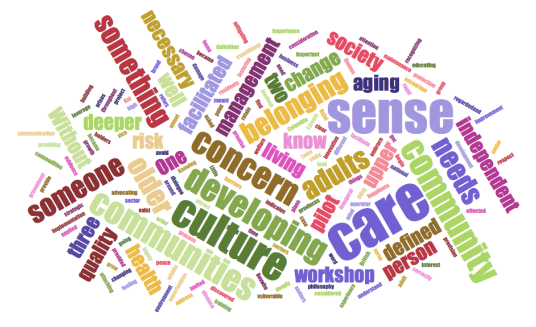|
As community and creative engagement facilitators, we find the most important aspect of our work is co-creating and holding safe space that fosters healing. A facilitator can have the greatest supplies, the ultimate agenda, the best intentions, amazing credentials- but none of that creates successful experiences for the participants if the space they walk into does not feel welcoming, inclusive and safe. The term crucible is used in family therapy as a metaphor for a relationship container- the concept of a holding environment. A crucible is a vessel made of material that does not melt easily, used for high temperature chemical reactions. Therapists, then, are not merely providing a container but also fostering the development of a container that already exists so that it can withstand the powerful effects of growth. As facilitators that hold safe space allowing for co-creation of the culture of care within an organization, it is our belief that individuals develop in environments that:
Relationships are the catalysts for individuals to develop. We recognize that this is an ideal and that organizations need help along the way to contain the heat ignited by growth and change. The crucible gets stronger as it takes more heat. When we work with an organization experiencing difficulties- our mandate is to ensure that the participants are safely guided within this crucible- that they feel cared for, heard, and empowered to find their voice. The space is a refuge in which participants are heard, and in which they hear. Ideally they collaborate with us to create this refuge. From the workshop outcomes, we then can develop next steps, and the process repeats:
Over time, the organization itself transforms into a safe space- a self-sustaining culture of care. Creating refuge is the process of organizing the environment so that participants are able to be more honest with each other in a way that facilitates intimacy, healthy boundaries and nurtures that process. Creating the safe space is an act of collaboration- between the facilitators, the hosts, and the participants. We co-create the space by how it is set up, how well the facilitators read the room dynamics, what is offered and setting intentions. And most importantly- through FLEXIBILITY. An agenda acts as a framework, but an agenda must also be allowed to breathe. We discover together. Collaboration is important not just because it's a better way to learn. The spirit of collaboration is penetrating every institution and all of our lives. So learning to collaborate is part of equipping yourself for effectiveness, problem solving, innovation and life-long learning in an ever-changing networked economy. – Don Tapscott
Once upon a time there was a Kat and a Bev...who got invited to facilitate a pilot project with the upper management of a national independent living brand and operator. Little did they know, that they would become deeply involved in developing and advocating for a culture of care in community and community living sectors for aging adults.
So why Culture of Care? The Dalai Lama indicates that for us to find peace and happiness we need to have three things in our communities; a Sense of Care, a Sense of Concern and a Sense of Belonging. This was the premise of our inaugural workshop where we facilitated a dialogue around what each sense meant to middle and upper management of three independent communities in two different provinces; two in British Columbia and one in Toronto. We then asked what are unmet needs, the barriers to those and what, if any, opportunities exist for innovation or change. We discovered themes throughout each community that provided evidence and absence of a deeper community care philosophy. The business of this sector is to care for seniors and older adults. Older adults are going to experience change through aging and are considered highly vulnerable. Knowing this, it was important to encourage all stake holders to embrace a culture of care and begin the process of developing deeper strategic plans and implementation. We know our communities of care are being effected by a rapid and changing environment. We understand that developing a culture of care is a high leverage point for communities and commodities in order to attract, retain and grow as well as address the transitional needs. Care is defined as the provision of what is necessary for the health, welfare, maintenance, and protection of someone or something, with attention or consideration applied to doing something correctly or to avoid damage or risk. It refers to feeling concern or interest; attaching importance to something, to look after and provide for the needs of. Without a sense of care, there can not be a sense of belonging. Without a sense of care, there can not be a sense of concern. And vice versa. One thing became clear when we facilitated the very same pilot workshop with a group of residents, that a sense of belonging and recognizing that this was their 'chosen home' was preeminent. The word culture is defined as the quality in a person or society that arises from a concern for what is regarded...and the development or improvement of the mind through educating or training. So a culture of care, in our definition, is the quality in a person or society that is providing what is necessary for the health and well being of 'someone', in this case, 'someone' being an older adult or senior, through developing communication, building respect, mitigating risk and fostering growth. |
AuthorsBeverley Pomeroy ArchivesCategories |




 RSS Feed
RSS Feed
